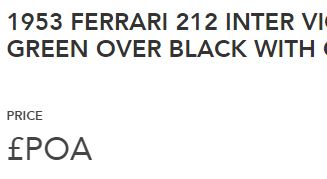
What does POA really mean when buying a car?
It’s frustrating when you see a car that you are interested in and when you finally get to the price, all it says is POA. So – why do sellers shy away from giving a price?
POA – or Price On Application (sometimes POR – Price On Request) – is the bane of many a classic car buyer. There’s nothing worse than ringing a dealer and asking for the price of a POA car only to get the response “Hang on, I’ll go and check…”. Check what? My bank balance? In the current market the use of POA in adverts has become widespread and although it’s not necessarily a cause for concern and alarm it’s useful to understand the reasons why a seller may decide not to display a price.
Reasons for using Price On Application.
- The seller doesn’t know how much the car is worth or how much to ask. Sometimes a seller won’t know how much their car is worth or can’t decide on a price but want it on the open market so it has a chance of selling. A price may appear at a later date.
- The market is moving fast. In a fast moving market sellers may not want to commit to a price in case they keep moving up. This is now a very common tactic and some dealers will have a target price in mind that they think they can achieve with the right conditions and buyer, but at the same time don’t want to be seen as “over-pricing”.
- They are reserving the right to change the price. Some sellers will be completely up front and let you know the the price today may not be the price tomorrow. We have even known sellers increase the price after a deal has been agreed.
- To generate a phone call. In a digital age it may not seem relevant but many dealers see a phone call as their only opportunity to sell a car to a potential buyer. They also believe that if a car is too expensive then they won’t get a call, so not displaying a price is an obvious solution to the problem.
- Customer filtering – to gauge how serious a buyer is. The basic premise is “If you have to ask the price you can’t afford it”.
- The car is SOR or on consignment. Sale or Return cars can create particular problems for dealers and there are lots of scenarios where not displaying a price is simply the easiest thing for a dealer to do. If the owner keeps moving the goalposts on price, is selling speculatively and is not desperate to part with the car, the car is not on the dealer premises or has been left on the premises for an extended period of time with no communication from the owner then they may display the car as POA. After all, if it’s not advertised it is not going to sell. Additionally, and depending on the sale or return agreement, the dealer may wish to hide the asking price from the owner – if it is agreed that a dealer will return X for a car and they sell it for X+50% then the owner may have other ideas about who should keep the additional profit. Additionally. the owner may wish to keep the sales price of the car confidential. It’s always useful to ask if a car is offered on a sale or return basis as it can change the dynamic of a transaction dramatically.
- Price protection/ price cloaking. This allows a seller to avoid any awkward questions if the price is going up or down. It also prevents other dealers from knowing the price, especially useful for rare vehicles or where they have cornered the market.
- The car is sold. Often when a car is sold but hasn’t yet been paid for it is left on the market POA in case the deal falls through.
POA – what to watch out for
- The seller has to check the price. This generally means the price isn’t fixed.
- The seller tries to qualify you before giving a price. This may mean they are trying to ascertain how deep your pockets are.
- The price keeps going up. We’ve known prices go up even after a deal has been agreed. Our view on this – don’t get involved.
- “Are you a serious buyer?”. Increasingly we have heard of customers being asked this. Should the level of your intent dictate the price of the car – presumably the more serious you are the higher the price?
- Sale or return. If the car is indeed on sale or return it’s worth establishing at the outset who is liable for any post sale issues in the eyes of the dealer – the selling owner or the dealer. The dealer will have a liability in the eyes of the law, but may feel the liability rests with the seller which could cause upset in the future.
- Price justification. A seller will generally compare their vehicle to others being offered in the marketplace. It’s worth checking the prices first (if that is possible) and remembering that the cars still for sale are the cars that haven’t sold.
There is no doubt that the numbers of cars offered without a “sticker” price has increased as sellers take advantage of a buoyant market with a considerable number of first time buyers. As an average across the types of vehicles we transact on behalf of customers around 15% will be offered on a POA basis with that average rising according to the perceived desirability and rarity of the vehicle.
If in doubt, please feel free to contact us to get an independent opinion on vehicle values.

